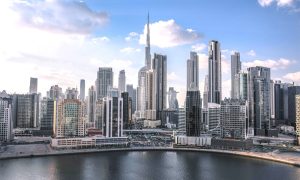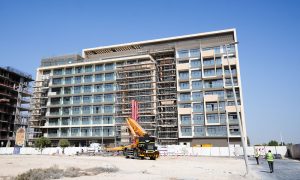Insight: Reassessing fire strategies
Sam Alcock, Tenable Fire Engineering Consultancy’s Dubai director, speaks to MECN about how fire and life safety strategies need to evolve, so as to protect buildings and their residents

With close to a decade’s worth of experience in a range of fire engineering consulting roles, Sam Alcock, Tenable Fire Engineering Consultancy’s Dubai director, is well-versed in understanding what it takes to develop a coherent and comprehensive fire and life safety strategy. Having worked on several large-scale international projects in the Maldives, Vietnam, Africa, Saudi Arabia, Oman, and the UAE, he has garnered a wealth of knowledge and insight into the many challenges that come with formulating safety codes, designing fire safety systems, performance-based fire design, and third-party verification, amongst others.
Alcock says that fire safety should be the responsibility of everyone on a project, and that the construction industry needs to reassess how it views fire safety design. With the industry going through a profound transformation in the wake of the COVID-19 pandemic, he believes that there is an opportunity ahead to improve codes and standards across the region, with governments and the private sector coming together to protect lives and prevent deadly accidents before they happen.
What makes for a good Fire and Life Safety Strategy?
The first thing is to be project specific – a lot of the time, the code is quite generic, and while I know people think that goes without saying, but a lot of times on projects that we’ve peer-reviewed, we have found that the strategy is very vague. So, for me, a key component of a good Fire and Life Safety Strategy is for it to be project specific, highlighting the fundamental requirements that are appropriate to ensure that you are not over-designing, or worse, under-designing. That is crucial, as you do not want to inhibit cost to the client by over-designing. However, you will also incur additional costs for the client if you under-design.
Another key component is explaining or identifying any performance-based designs. If you have a unique building and must use CFD, or if you are using an evacuation model to justify extended travel distances, then that has to be clearly identified within the fire strategy, because that is the approach one is taking. So, in the future, should there be any modifications, someone would be able to read the strategy report and go, ‘Right, this what they have done; and this is why they did it’.
For example, if we’re doing a fit-out in a mall for a large tenant, then we have to follow that mall’s fire strategy. If that mall’s strategy is not clear enough, or if they haven’t mentioned something like, ‘all independent or large retail units in the mall require smoke control’, and if the code that we are designing to doesn’t require that, then we are not going to provide smoke control for that specific retail unit, because it’s not been mentioned in the strategy report. However, if the report does say that all retail units should have smoke control, then we are going to design it into the system.
This illustrates how important it is to have clear-cut information, because otherwise, you’ll face difficulties later on and there will be knock-on effects.
One of the most important components of any fire and life safety strategy is to record and note any discussions with the authorities, where relaxations and exemptions have been discussed and agreed upon. That’s very important, because if they are not recorded, then who is really going to know?
How do you ensure that the Fire and Life Safety Strategy is an integral part of the construction process?
It’s very difficult – unless we are actually appointed during the construction phase, we can’t ensure that. We hope that everyone follows the original strategy and intent, but unless we, or another fire consultant, is actually appointed during the construction phase, then we are not really going to know if it’s being followed.
The benefit we have in the UAE is the Civil Defence – when you make a submission and receive Civil Defence approval, these drawings are well detailed, and if any changes or modifications are made to these drawings during the construction phase, you have to resubmit them to Civil Defence.
This is so that when the building is complete, and the inspectors carry out their assessment, they will be able to see that these drawings match what is constructed.
This gives a bit of comfort to the likes of us, because if we’re not involved in the construction stage, then at least these are the steps that have to be legally followed.
Of course, if we are appointed early in the construction process, then it’s a completely different story.
Who is ultimately responsible for the Fire and Life Safety Strategy of a project?
In my opinion, everyone is responsible. The fire strategy report caters to every single discipline involved on a project. Everyone is responsible, but ultimately, it’s really the fire engineering consultancy’s responsibility to ensure that the strategy is followed. During construction, there are always minor tweaks or changes, or optimisation or value engineering takes place. This has to be managed by the fire engineering consultant to ensure these changes are not compromising on any life safety matters.
Finally, what can you say about how the private sector can work with the government sector to improve standards?
The UAE has a very robust code, and so does Saudi Arabia. They follow a lot of the International Building Code, which is great to see. While all countries have their own codes or specific requirements, some of them are not as thorough or detailed as the UAE or Saudi codes. A lot of them have certain requirements, but also give the flexibility to use international standards like the NFPA or IBC codes practice. Wherever their code is silent or doesn’t go into detail, they refer back to international best practices.
My opinion is that each country should have a committee, formed by the government and the private sector. Also, like the NFPA and IBC codes practice, a new version of the code should be released every few years. There will be changes compared to previous editions, but these will be highlighted within the code. All of these changes come from professional opinions and the latest trends and put to the committee to be accepted. Only when all of this is agreed upon and is it then put into code.
There is a lot of planning that goes into it.






















